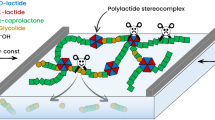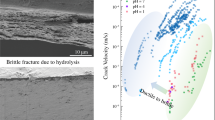Abstract
Poly[(rac-lactide)-co-glycolide] (PLGA) is used in medicine to provide mechanical support for healing tissue or as matrix for controlled drug release. The properties of this copolymer depend on the evolution of the molecular weight of the material during degradation, which is determined by the kinetics of the cleavage of hydrolysable bonds. The generally accepted description of the degradation of PLGA is a random fragmentation that is autocatalyzed by the accumulation of acidic fragments inside the bulk material. Since mechanistic studies with lactide oligomers have concluded a chain-end scission mechanism and monolayer degradation experiments with polylactide found no accelerated degradation at lower pH, we hypothesize that the impact of acidic fragments on the molecular degradation kinetics of PLGA is overestimated. By means of the Langmuir monolayer degradation technique, the molecular degradation kinetics of PLGA at different pH could be determined. Protons did not catalyze the degradation of PLGA. The molecular mechanism at neutral pH and low pH is a combination of random and chainend-cut events, while the degradation under strongly alkaline conditions is determined by rapid chainend cuts. We suggest that the degradation of bulk PLGA is not catalyzed by the acidic degradation products. Instead, increased concentration of small fragments leads to accelerated mass loss via fast chain-end cut events. In the future, we aim to substantiate the proposed molecular degradation mechanism of PLGA with interfacial rheology.
Similar content being viewed by others
References
X. Ma, S. Oyamada, T. Wu, M. P. Robich, H. Wu, X. Wang, B. Buchholz, S. McCarthy, C. F. Bianchi, F. W. Sellke and R. Laham, Journal of Biomedical Materials Research Part A 96A (4), 632–638 (2011).
S. Mathew, S. Baudis, A. T. Neffe, M. Behl, C. Wischke and A. Lendlein, European Journal of Pharmaceutics and Biopharmaceutics 95, 18–26 (2015).
X. Zhu and R. D. Braatz, Journal of Biomedical Materials Research Part A 103 (7), 2269–2279 (2015).
B. Laycock, M. Nikolić, J. M. Colwell, E. Gauthier, P. Halley, S. Bottle and G. George, Progress in Polymer Science 71 (Supplement C), 144–189 (2017).
C. F. van Nostrum, T. F. J. Veldhuis, G. W. Bos and W. E. Hennink, Polymer 45 (20), 6779–6787 (2004).
A. Kulkarni, J. Reiche and A. Lendlein, Surface and Interface Analysis 39 (9), 740–746 (2007).
S. J. de Jong, E. R. Arias, D. T. S. Rijkers, C. F. van Nostrum, J. J. Kettenes-van den Bosch and W. E. Hennink, Polymer 42 (7), 2795–2802 (2001).
M. C. Hamoudi-Ben Yelles, V. Tran Tan, F. Danede, J. F. Willart and J. Siepmann, Journal of Controlled Release 253, 19–29 (2017).
J. Siepmann, K. Elkharraz, F. Siepmann and D. Klose, Biomacromolecules 6 (4), 2312–2319 (2005).
A. C. Schone, T. Roch, B. Schulz and A. Lendlein, J R Soc Interface 14 (130) (2017).
H. C. Kim, H. Lee, H. Jung, Y. H. Choi, M. Meron, B. Lin, J. Bang and Y.-Y. Won, Soft Matter 11 (28), 5666–5677 (2015).
J. Li, P. Nemes and J. Guo, Journal of Biomedical Materials Research Part B: Applied Biomaterials 106 (3), 1129–1137 (2018).
Author information
Authors and Affiliations
Corresponding author
Rights and permissions
About this article
Cite this article
Machatschek, R., Schulz, B. & Lendlein, A. The influence of pH on the molecular degradation mechanism of PLGA. MRS Advances 3, 3883–3889 (2018). https://doi.org/10.1557/adv.2018.602
Published:
Issue Date:
DOI: https://doi.org/10.1557/adv.2018.602




